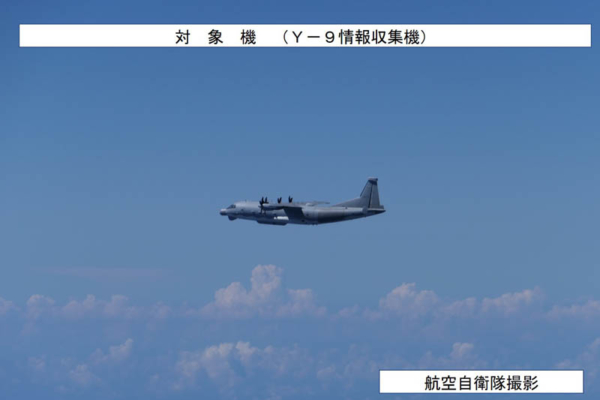On August 26, a Chinese military reconnaissance aircraft for the first time breached the airspace off Japan’s southwestern coast, prompting Japan’s Ministry of Defense to lodge a strong protest with the Chinese Ministry of Foreign Affairs through diplomatic channels. China claimed that the aircraft unintentionally entered Japanese airspace and urged against “overinterpretation.” Several experts believe that this intrusion by the Chinese military aircraft into Japanese airspace was a probing, pressurizing, and retaliatory action.
The Japanese Ministry of Defense announced on August 26 that a Chinese Yun-9 reconnaissance aircraft violated Japanese airspace near the Senkaku Islands in Nagasaki Prefecture around 11:29 a.m. The Defense Ministry stated that this was the first confirmation of a Chinese military aircraft violating Japanese airspace.
On the 27th, Japanese Defense Minister Toshimitsu Motegi stated in a press conference, “This not only seriously violates our country’s sovereignty but also poses a threat to security. We completely cannot accept it. We have lodged a strong protest with China and demanded the prevention of such incidents from reoccurring.”
This week, a bipartisan delegation led by John Moolenaar, the chairman of the U.S. House of Representatives’ Special Committee on China, visited Japan. Regarding the incident of a Chinese spy plane trespassing into Japanese airspace, Moolenaar stated on the 28th that it has rung alarm bells in Tokyo, making it realize the aggressive nature of China.
Veteran Japanese media personality Akio Yaita, in an interview with reporters, said that the timing of the Chinese military aircraft’s intrusion into Japanese airspace is driven by three main motives:
Firstly, with Japan currently in the process of changing prime ministers and Fumio Kishida serving as the acting prime minister, it is unlikely for Japan to take any strong actions. China perceives Japan’s reluctance to respond strongly, hence deliberately engaging in this aircraft intrusion as a probe to assess the Japanese government’s reaction for future strategic evaluations.
Secondly, China intends to provoke Japan during the Liberal Democratic Party leadership elections, serving as psychological intimidation towards the Japanese people.
Yaita explained, “In the LDP presidential election, there are those known as hawks who take a hardline stance towards China, such as Sanae Takaichi and Takaaki Koga, and those considered to be more pro-China, like Shigeru Ishiba, Yoshimasa Hayashi, or Taro Kono.”
Yaita bluntly stated that China may be seeking retaliation, especially in response to Japan’s Maritime Self-Defense Force entering Chinese territorial waters in July while monitoring Chinese military exercises.
According to a report by Kyodo News on the 28th, Toshihiro Nikai, the chairman of the bipartisan Japan-China Friendship Parliamentarians’ League, and Li Zhanshu, chairman of the National People’s Congress Standing Committee of China, held talks at the Great Hall of the People in Beijing. Nikai expressed regret over the Chinese military aircraft’s intrusion into Japanese airspace, strongly urging China to prevent such incidents from recurring. Li claimed that China “did not intend to do so.”
Regarding the Chinese Foreign Ministry’s statements on the 27th and 28th asserting that they had no intention of violating any country’s airspace, Secretary-General Wang Zhisheng of the Asia-Pacific Elite Exchange Association mentioned that although the Yun-9 reconnaissance aircraft only entered Japanese airspace for about 2 minutes, reports indicate that it circled around the area for a total of 49 minutes before and after, making the claim hard to believe.
Wang Zhisheng believes that Li Zhanshu’s statement reflects China’s top-level desire not to be seen as deliberately provoking, attempting to defuse tensions to prevent the escalation of a single event into localized military conflicts.
Chen Wenjia, Director of the National and Regional Development Research Center at Kainan University, also stated that while on the surface, the Chinese military aircraft’s mission appears to be electronic reconnaissance, there are deeper strategic considerations involved. The action sends a political message to the U.S. and Japan, showcasing China’s deterrence capabilities in the East China Sea region and issuing a warning to countries in East Asia and the South China Sea, especially those involved in territorial disputes.
Chen further elaborated that apart from testing Japan’s airspace defense capabilities and response speed, China is also conducting a test of the U.S.-Japan alliance, observing how the U.S. reacts and acts when faced with such provocations in Japan to evaluate the practical effects of the U.S.-Japan Security Treaty.
Given the serious economic downturn, rising unemployment, and internal instability pressures faced by mainland China, Chen believes that China is using aggressive diplomacy and military actions to divert domestic attention from internal issues and instigate nationalist sentiments to consolidate its authoritarian leadership position.
Furthermore, Chen pointed out that China aims to use this incident to pressure Japan diplomatically, gaining negotiation advantages in economic cooperation, technological exchanges, and territorial disputes such as the Senkaku Islands, and compel Japan to make concessions in other bilateral negotiations through military threats.
Lastly, Chen mentioned that if such incidents continue to occur frequently, it will lead to normalization of friction between China and Japan, further impacting the geopolitical security of the Asia-Pacific region. He believes that Japan will accelerate its military modernization process as a result and seek to play a more proactive role on the international stage, potentially intensifying an arms race in the Indo-Pacific region and even leading to the emergence of a “security dilemma.”

